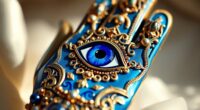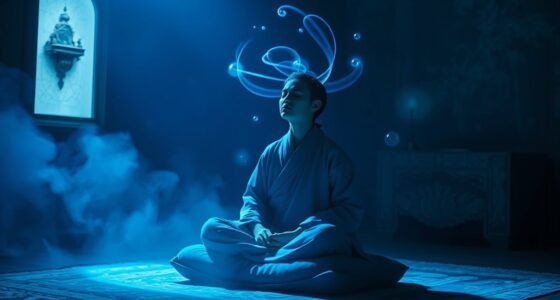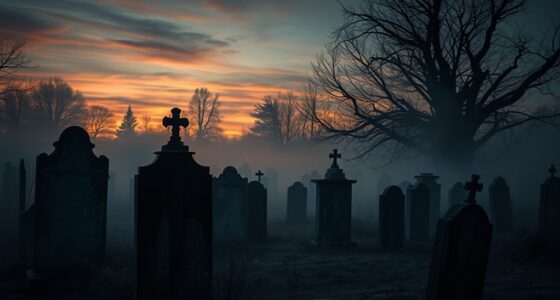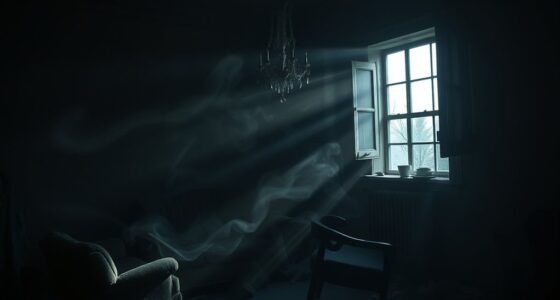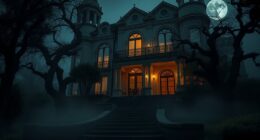Since we were kids, vampire stories have scared us. They are creatures of the night that show our deepest fears. These old myths aren’t just stories. They reflect our worries about death, being different, and breaking rules.
Key Takeaways
- Vampire folklore shows how societies punished those who didn’t follow the rules, like the Abhartach of Ireland.
- Lilith’s story shows how being independent was seen as dangerous in old myths, linking to gender roles.
- Churches used vampire stories to control people, linking vampirism to heresy in medieval Europe.
- Archaeology, like the brick-in-mouth skeleton in Venice, proves these myths were once real fears.
- From porphyria’s misunderstood symptoms to Mercy Brown’s tragic 19th-century exhumation, these stories ask: What’s real, and what do they say about you?
These supernatural beings aren’t just monsters. They’re echoes of our deepest fears. This journey into ancient vampire mythology will show how folklore shaped history, science, and your nightmares. Are you ready to face what the dark reveals?
The Ancient Origins of Vampire Mythology
Before Bram Stoker’s Dracula, vampire myths had deep roots in ancient rituals and beliefs. These early stories turned death into tales of the undead. Let’s explore how these fears became lasting legends.
Prehistoric Blood Rituals and Their Connection to Vampire Lore
| Culture | Vampire Figure | Beliefs |
|---|---|---|
| Mesopotamia | Ekimmu | Spirits trapped between worlds, seeking revenge |
| Celtic Ireland | Abhartach | A chieftain cursed to drink blood after death |
| Ancient Greece | Lamia | Child-eatingting demons linked to maternal loss fears |

First Documented Vampire Cases in Medieval Europe
In medieval Europe, real events turned into vampire folklore. In 11th-century Serbia, people dug up bodies they thought were vampires. They even staked one man through the heart to keep him from coming back.
These actions were based on misunderstandings of decomposition. People thought bloated corpses were vampires.
How Ancient Burial Practices Fueled Vampire Beliefs
Communities used burial practices to stop vampires. They buried bodies face-down to prevent them from rising. In Greece, they placed stones on graves to trap spirits.
These practices show how death rituals became vampire superstitions. They mixed science and myth.
These ancient roots reveal vampire myths are more than stories. They are a peek into how early humans explained the unknown.
Legends of Vampires: Humanity’s Fear Unveiled
Vampire myths across the world show our deep fears. These stories are not just tales—they speak of cultural fears and mortality anxiety. Vampires mirror our fears of death, power, and control.
Consider vampire psychology: figures like Elizabeth Bathory and Vlad the Impaler. Their actions fueled myths. These stories make sense of violence by turning it into supernatural threats.
Now, let’s look at folklore analysis worldwide:
- Egyptian myths spoke of the ka, a spirit that drank blood if neglected—tying death to moral failure.
- China’s Ch’iang-shih feared improper burials, linking vampirism to dishonored spirits.
- Sumerian ekimmu, restless souls of the violently dead, show how ancient cultures tied death rituals to survival.

Archaeologists found “vampire burials” in Europe: bodies staked or decapitated. These acts were not just superstition. They were desperate attempts to control the uncontrollable. Your fears of the unknown and losing control are reflected in these rituals. Even today, cases like 19th-century America’s Mercy Brown panic show mortality anxiety still exists.
Next time you see a vampire, think: what’s the story really about? It’s not just about blood—it’s humanity’s oldest questions, wrapped in fangs and shadows.
Dracula and Vlad the Impaler: Where History Meets Horror
Step into a world where history and horror stories come together. The story of Bram Stoker’s Dracula and Vlad the Impaler shows how a 15th-century leader became a symbol of terror.
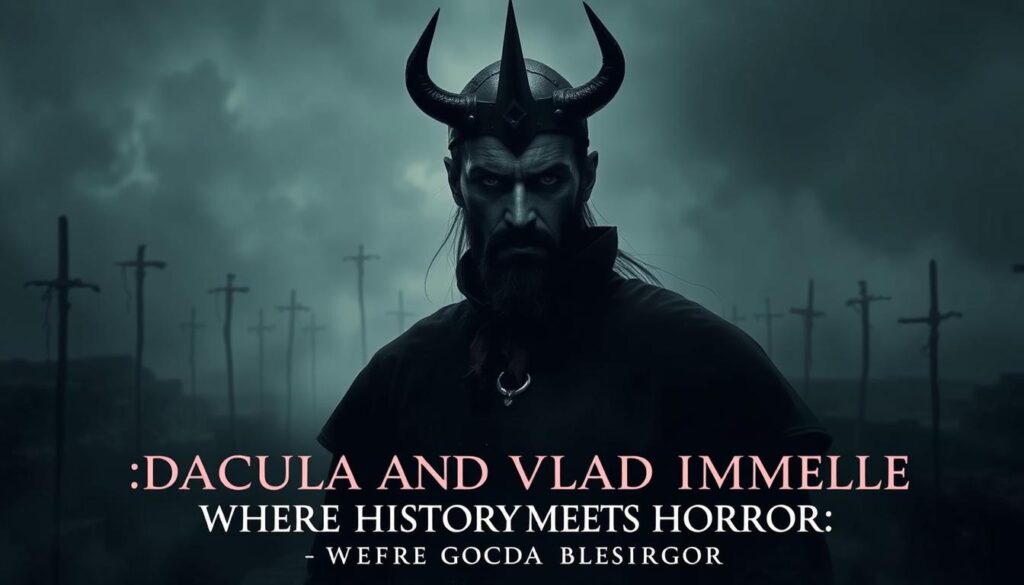
The Real Historical Figure Behind the Legend
Vlad III Dracul, known as Vlad the Impaler, ruled Wallachia with fear. He was known for his brutal feasts, where he dipped bread in blood. This gruesome act was later used in Stoker’s story.
His method of execution by impalement made him infamous. Yet, it wasn’t until centuries later that he became known as a historical vampire figure through literature.
Bram Stoker’s Transformation of Vlad into Count Dracula
Stoker took Vlad’s violent past and turned it into a mythic figure. He kept Vlad’s name and cruelty but added supernatural twists. These included immortality and the power to hypnotize.
The title Bram Stoker’s Dracula mixed fact and fiction. It turned a medieval ruler into a timeless symbol of darkness.
How Dracula Embodied Victorian Era Fears and Anxieties
Victorian readers saw their fears in Dracula’s dark charm. His predatory nature reflected their worries about sex, disease, and foreign threats. The novel’s Gothic style made these fears even more intense.
It showed how society’s hidden fears could be reflected in a character. Dracula became a mirror for these unseen dangers.
Blood, Death, and Immortality: The Psychological Roots of Vampire Fascination
Vampire psychology explores our deep fears. It makes us face our fear of death. Vampires show us how to cheat death with immortality myths. Their blood thirst mirrors our desires and fears.
| Theory | Interpretation |
|---|---|
| Jungian analysis | Vampires symbolize the “shadow”—repressed urges and mortality fears we project onto monsters. |
| Freudian view | Link to Eros (life drive) and Thanatos (death drive): blood-drinking as a clash between desire and dread. |
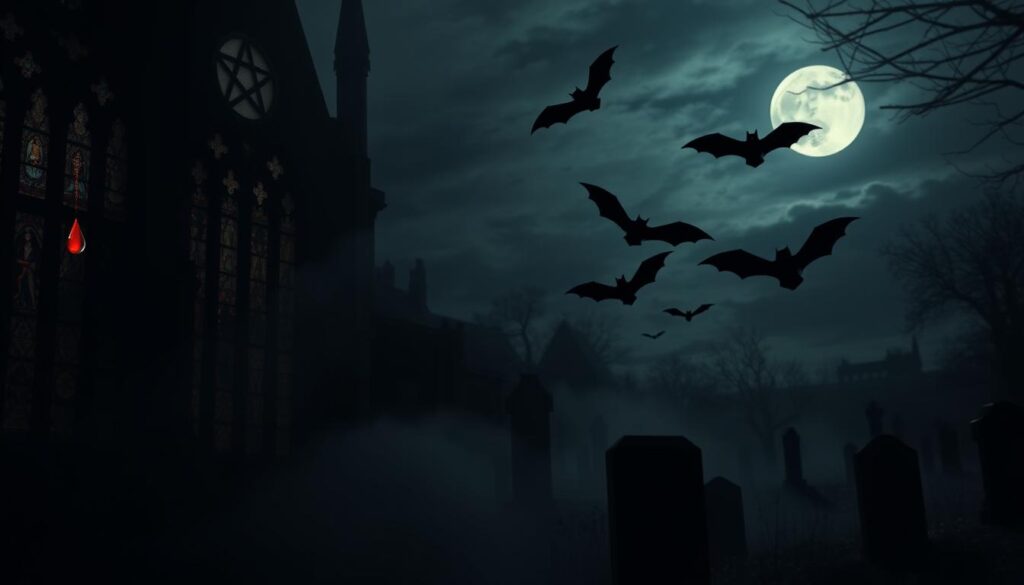
Blood symbolism in myths is complex. It represents life, power, and forbidden love. Medieval rituals, like drinking blood to cure epilepsy, show our quest for control over death. Modern tales like Twilightor Buffy the Vampire Slayer still explore this mix.
- Blood as life force (Kristeva’s “abjection” theory)
- Sexuality and transgression
- Legacy and immortality
Studies like Baldwin & Ripley (2020) show vampire cults attract teens seeking identity. Even ancient rituals, like Papua New Guinea’s Fore people consuming blood, share this quest. So, when you watch a vampire movie, ask: are you drawn to the horror… or the hope?
Eastern European Vampire Traditions That Will Chill Your Blood
Imagine finding a skeleton with a rusted sickle on its legs. Or a corpse buried face-down with a padlock on its toe. These discoveries show Eastern Europe’s vampire myths were real. From Romania’s Strigoi to Russia’s eretik, these legends were based on deep fears of the unknown.

The Strigoi of Romania: More Terrifying Than Fiction
Romanian Strigoi were more than just bloodsuckers. They could possess people, haunt dreams, or spread plagues. To protect themselves, villagers buried the dead with sickles or spikes through the heart.
A 17th-century skeleton found in Bulgaria in 2014 had a sickle over its pelvis. This proves these rituals were real. Unlike Dracula, Strigoi were ugly, bloated corpses that haunted families.
Polish and Russian Vampire Myths: Darker Than You Think
Russian eretik were cursed heretics who came back as undead predators. In Poland, the upior could rise from any unclean death. Even today, digs find proof: a 2014 Polish dig uncovered 450 decapitated bodies buried as vampires.
A 1720s case in Serbia about Petar Plogojowitz became real news. After his death, villagers claimed he returned and attacked them. His “undecomposed” body fueled panic.
Protection Against Vampires: Ancient Rituals That Still Haunt Us
To stop the dead, villagers used brutal methods. Burial rites included:
- Driving iron rods through the heart
- Burying bodies face-down
- Stomping garlic in the mouth
In 2014, a Bulgarian grave held a young woman with a padlock on her toe. This was only the second such find ever recorded. These methods reflected fears of diseases like TB, which made bodies appear “undead.”
| Culture | Vampire Type | Key Traits |
|---|---|---|
| Romania | Strigoi | Could become undead during life; caused sickness |
| Russia | Eretik | Heretics cursed to feed on the living |
| Poland | Upior | Appeared as mist or shadows; spread madness |
These rituals weren’t just myths—they were survival tactics in a world without modern medicine. Next time you watch a vampire film, remember: the real stories were even scarier.
Vampire Legends Across Asian Cultures You’ve Never Heard About
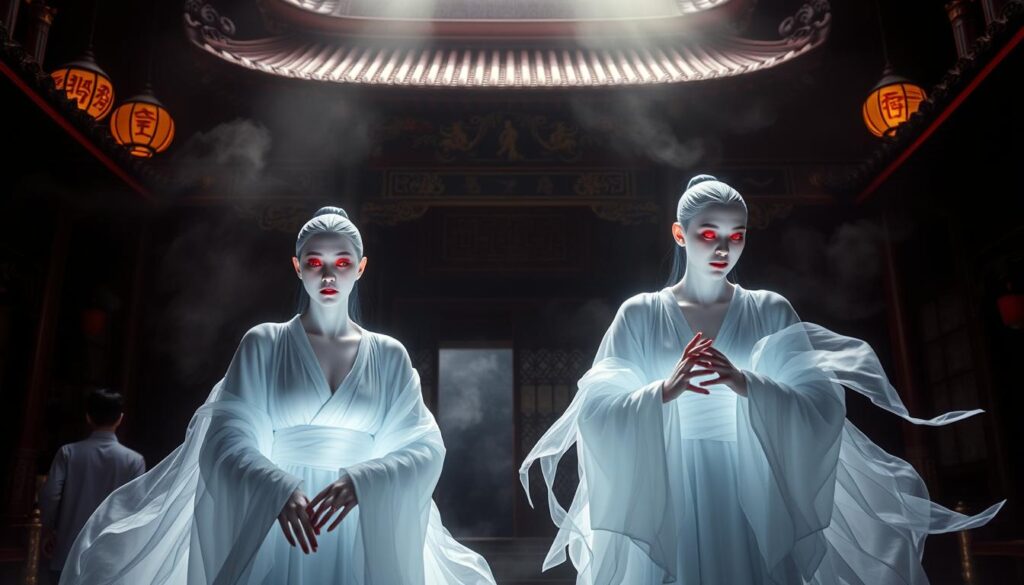
Forget the clichés of European vampires. Asian vampire myths show a darker, stranger world of the undead. These myths reveal fears unique to their regions, from hopping corpses to flying organs.
“Vampire myths are reinterpreted in Japanese animation, highlighting how cultural fears shape folklore,” says scholar Alice Teodorescu. Yet Asia’s vampire legends often stay hidden from global pop culture.
The Jiangshi of China are stiff-armed hopping corpses. They terrorize villages, driven by Taoist beliefs about improper burials. Their greenish skin and fear of mirrors make them Asia’s answer to the undead.
Malaysia’s Penanggalan is a vampiric head that floats through the night. Its intestines dangle, targeting pregnant women. Locals ward them with protective amulets.
The Philippines’ Aswang is a shape-shifter. By day, they’re ordinary villagers. By night, they transform into predators, feeding on children or viscera. This shows how fears of outsiders are expressed uniquely.
Even ancient India’s Rakasha from the Brahmanda Purana show how Asian vampires predate modern myths. These blood-drinking demigods, born from darkness itself, prove these legends are deeply rooted in local traditions.
These Asian vampires aren’t just monsters—they’re mirrors. They expose fears of death, betrayal, and the supernatural’s intrusion into daily life. Next time you think of vampires, remember: the real horror lies in what cultures choose to fear.
How Medical Conditions Were Mistaken for Vampirism Throughout History
In ancient times, people didn’t understand sicknesses. They blamed the undead for what we now know is caused by science. For example, a rare blood disorder called porphyria made people’s skin sensitive to sunlight.
Their urine looked reddish, and their gums seemed to recede, making them look like they had fangs. This led to myths about vampires.

| Disease | Symptoms | Vampire Myth |
|---|---|---|
| Porphyria | Photosensitivity, reddish urine | Avoiding daylight, “blood-red” fluids |
| Rabies | Foaming at the mouth, aggression | Violent “attacks” and thirst for blood |
| Tuberculosis | Blood-tinged coughs, weight loss | Belief the dead drained life from families |
- Bloating corpses were seen as “feeding”
- Fluids from decomposing bodies appeared as “blood”
- Catalepsy caused some to be buried alive, reinforcing vampire myths
Today, we know these were natural processes. Corpses’ skin shrinks, making teeth look like fangs. Rabies made people afraid of water, fitting vampire stories.
Tuberculosis spread in families, leading to vampire myths. These medical issues shaped vampire legends for centuries.
The Evolution of Vampire Appearance and Powers in Folklore
Imagine looking through centuries of vampire stories and seeing how they changed. The vampire appearance evolution shows how human fears have shifted. At first, vampires were seen as bloated corpses with bloody mouths. Now, they are sleek and pale.
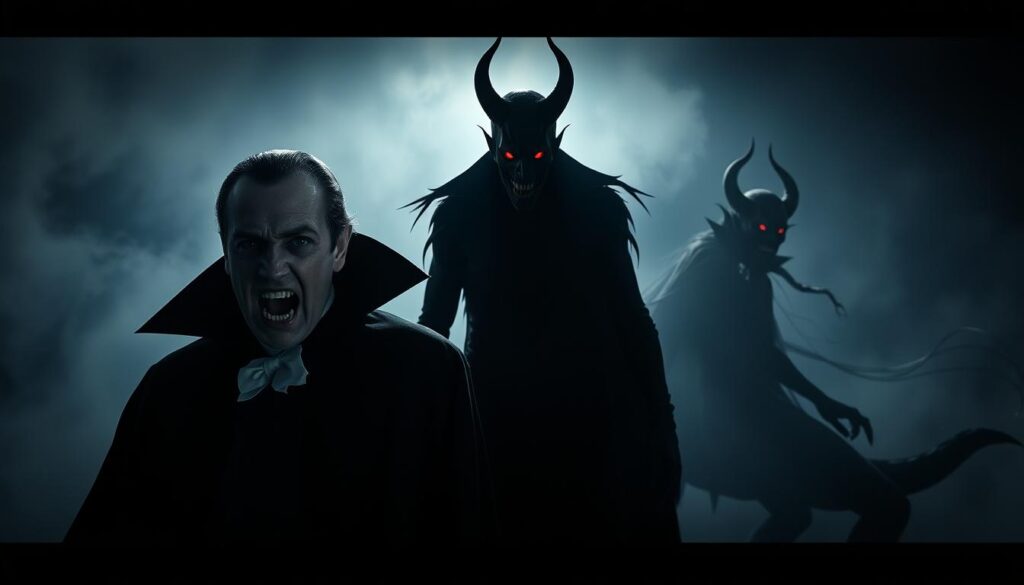
His face was a mass of flesh, with a high, broad forehead, straight nose, and a heavy, square jaw. His eyes were large, deep-set, and dark, but his most striking feature was a mouth twisted into a rictus grin, revealing sharp, pointed teeth.
Bram Stoker’s Dracula mixed horror and nobility. His pale skin and sharp features became a model for later vampires. Over time, vampire powers grew. They could now shape-shift and control minds, as seen in The Strain.
- 19th-century vampires symbolized war fears (e.g., Captain Vampire linked to Russian invasions).
- Early 20th-century tales like The House of the Vampire explored mental decay and loss of identity.
- Today’s vampires, like Twilight’s Edward Cullen, reflect a shift toward sympathetic figures battling internal conflicts.
Sunlight became a vampire weakness later. Bram Stoker’s Dracula wasn’t harmed by daylight. This change came from F.W. Murnau’s 1922 film Nosferatu. This shows how myths evolve with new fears, blending old and new.
Female Vampires and Their Unique Role in Revealing Social Fears
Lilith is a figure from ancient myths and Jewish tradition. She is the first female vampire. Born in stories like the Sumerian Gilgamesh, she refused to be subservient to Adam. This act of defiance against patriarchal norms turned her into a monster, showing fears of women not following traditional roles.
Over time, female vampires became symbols of standing up against gender expectations. They showed that women could be more than just what society expected.

In Victorian literature, Carmilla’s story exposed the cracks in society. Joseph Le Fanu’s 1872 novella showed her as a predator targeting women. This challenged the sexual taboos of the time.
Her bond with Laura broke the norms of heteronormativity. This revealed the anxieties about female desire. Society saw such defiance as monstrous, viewing female autonomy as a threat to gender roles.
Now, modern tales see female vampires as symbols of power. Lilith and Carmilla’s stories inspire new narratives. They once represented patriarchal fears of women’s independence. Today, they symbolize resistance and liberation.
When you see female vampires today, you see centuries of resistance. This resistance spans from medieval myths to modern screens.
How Hollywood Transformed Vampire Legends for Modern Audiences
Vampire films have changed old myths into stories for today’s viewers. From silent film scares to love stories, Hollywood has made vampires reflect our fears and dreams. Let’s see how directors like F.W. Murnau and Francis Ford Coppola made Dracula movies big hits.
Nosferatu to Twilight: The Century-Long Evolution
Begin with Nosferatu (1922), a Dracula remake without permission). Its eerie Count Orlok scared people before the Depression. Later, vampires became romantic in films like 1992’s Bram Stoker’s Dracula. Twilight made vampires cool for teens. This change shows how vampires now evoke sadness rather than fear.
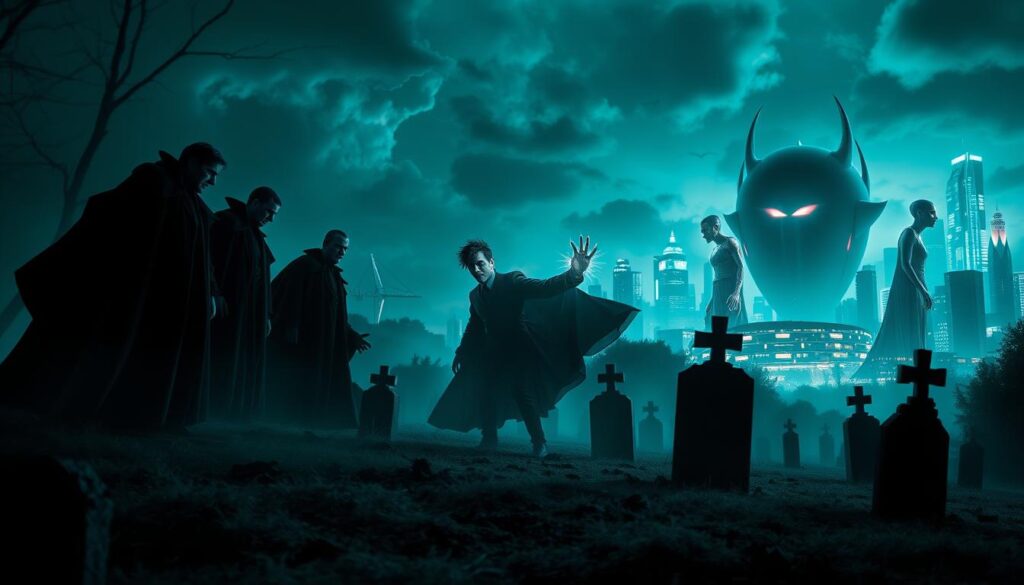
How Film Vampires Reflect the Fears of Their Era
- Dracula (1931) scared people in the 1930s with Lugosi’s noble evil.
- In the 1980s, Interview with the Vampire reflected fears of AIDS through blood horror.
- Today, What/Where the Blood Clots (2020) uses vampires to talk about digital loneliness.
The Sympathetic Vampire: From Monster to Misunderstood Anti-Hero
Anne Rice’s Interview with the Vampire gave Louis a heart, making him a tragic hero. Modern shows like True Blood show vampires as victims of hate, mixing horror with social messages. These tales ask: what makes a monster? And are they just like us?
Scientific Explanations Behind Vampire Hysteria and Folklore
Ever wondered why vampire myths still exist today? Science gives us clues through mass hysteria, psychological analysis, and cultural anthropology. Let’s explore how these forces created legends.

“Vampire tales thrive where science lacks answers,” note experts studying pre-industrial societies.
In the 1720s, Serbia saw a case that caused mass hysteria. A man named Petar Blagojević was found with his body not decomposing. People blamed him for deaths. The panic was documented by Austrian officials, showing how myths arise in times of crisis.
| Factor | Explanation | Example |
|---|---|---|
| Mass Hysteria | Communities scapegoat individuals during crises | Blagojević’s exhumation and burning |
| Psychological Analysis | Jung’s shadow theory: vampires embody forbidden desires | Fear of death → immortal monster myths |
| Sociological Explanations | Legends enforce social norms by punishing “deviants” | Victims were often outsiders or those who died unmarried |
| Cultural Anthropology | Myths explain the unexplained | Garlic’s antibacterial use led to vampire lore |
| Folklore Development | Legends evolve with local beliefs | Eastern Europe’s stakes vs. China’s hopping vampires |
Science shows how folklore development tries to explain mysteries. A disease called porphyria might have inspired vampire traits. Today, these stories continue because they touch on deep fears of death and the unknown. Next time you watch a vampire movie, think about it: it’s not just fiction. It’s your brain’s way of dealing with things science can’t explain yet.
Real Historical Vampire Panics That Gripped Entire Communities
In the 1800s, fear of the undead led to desperate acts. In New England, families with tuberculosis turned to New England vampire folklore. They believed sick loved ones were cursed. The 1892 case of Mercy Brown is infamous: her heart was burned to “stop” her from draining her brother’s health. These vampire panics show how disease and myth collided.
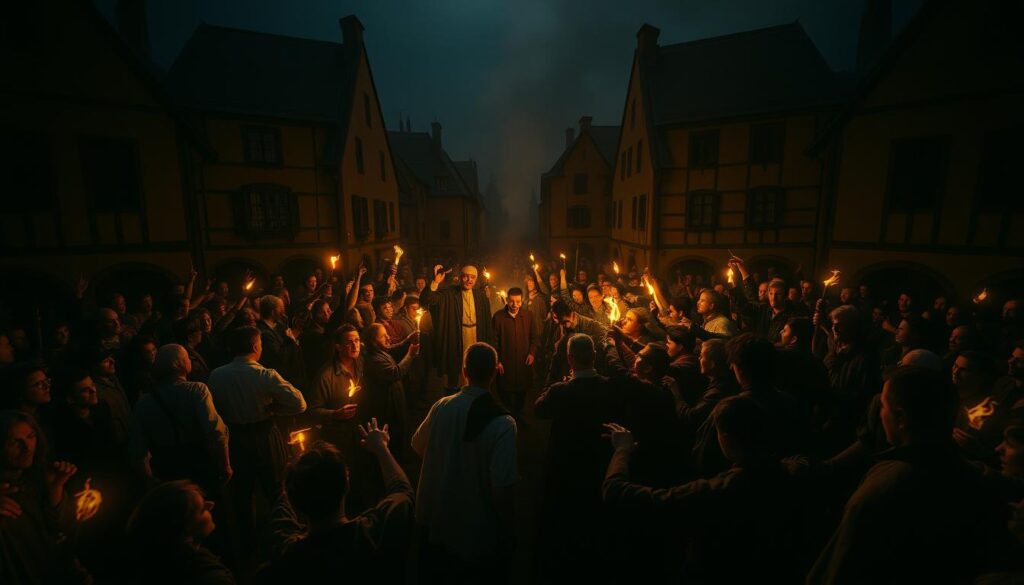
New England’s Dark Folklore
In Rhode Island, Mercy Brown’s body showed no decomposition—a sign of vampirism. Her remains were burned in a ritual to end the family’s suffering. This case is a chilling example of historical vampire cases rooted in New England vampire folklore.
Eastern Europe’s Official Vampire Cases
- Jure Grando (1672): Croatia’s first documented vampire, buried with a stake through his heart.
- Peter Blagojevic (1725): His exhumation by Habsburg officials became a sensational record of vampire panics.
- Archaeological finds: Graves in Poland with iron rods through skeletons show anti-vampire rituals persisted into the 18th century.
Modern Vampire Beliefs Today
| Case | Location | Details |
|---|---|---|
| Highgate Vampire (1970s) | UK | Grave desecration in London’s Highgate Cemetery sparked panic over a “vampire lord.” |
| Mombasa Fire Station Attack (1947) | Kenya | Rumors of firemen extracting blood led to a mob destroying a fire station. |
| Amazon Vampire Scares | Brazil | Modern tales of blood theft by elites persist in rural regions today. |
These stories show modern vampire beliefs aren’t relics of the past. From colonial Kenya to today’s Amazon, fear of the supernatural still erupts. Communities face the unknown, leading to vampire panics. Every era reflects its deepest anxieties—whether disease, colonial rule, or distrust of authority.
Why Vampire Legends Persist in the Age of Science and Reason
Why do vampire stories still scare and captivate us in a world of science and reason? Their modern vampire appeal lies in their ability to mirror our deepest fears and desires. These myths achieve cultural longevity by evolving to reflect current anxieties, from pandemics to technology run amok. Every era reimagines them to explore what scares us most.
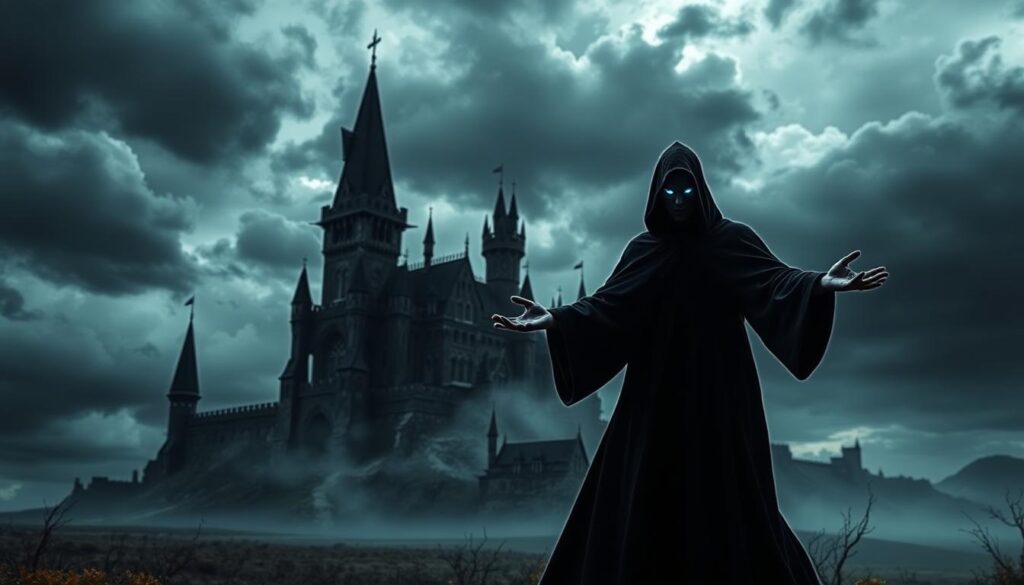
Karl Marx’s 1844 metaphor for capitalism captures their metaphorical significance. Vampires embody timeless tensions—immortality vs. mortality, fear of the “other,” and hidden threats. They survive because they adapt: 19th-century Dracula symbolized colonial anxieties, while 21st-century tales like What We Do in the Shadows mock modern social norms. Their psychological relevance taps into primal fears of loss, powerlessness, and mortality in a secular age.
- Pop culture influence thrives through TV, films, and books that recast them as antiheroes or societal critiques.
- Their liminal state—neither alive nor dead—lets us project current fears onto ancient templates.
- From Bram Stoker’s aristocratic monster to Twilight’s brooding Edward, each version reflects era-specific struggles.
These myths endure because they’re flexible metaphors. They let you confront taboo topics like sexuality, power, or existential dread through the safety of fiction. Vampires won’t fade—they’ll just keep changing, proving horror’s oldest stars are also its most adaptable.
Conclusion: What Your Fascination With Vampires Reveals About Human Nature
Your love for vampire stories is more than just about blood and fangs. It shows how you see fears and desires. These enduring myths connect to the collective unconscious, a shared part of human experience.
The vampire’s thirst for blood reflects your own battles with control and mortality. It also touches on forbidden desires. This shows how vampire stories mirror your inner struggles.
From Bram Stoker’s Dracula to today’s TV shows, vampire tales hold deep cultural significance. They make you think about what you fear most. Is it death or losing control?
The vampire’s curse is a mirror to your self-reflection on life’s limits. Early myths, like the Strigoi, warned of disease. Today’s vampires, like in Fledgling, delve into identity and power. Each era reimagines vampires to match its fears.
Vampire stories make you face your inner demons. Their immortality speaks to your desire to cheat death. Their loneliness echoes our own modern isolation. The crucifix and garlic are more than just symbols—they represent the battle between our primal nature and morality.
So, when you watch a vampire story, think about what part of yourself you see in their eternal night.

